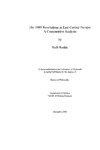1989 revolutions in east-central Europe : a comparative analysis
| dc.contributor.author | Rodda, Ruth | |
| dc.contributor.other | School of Society and Culture | en_US |
| dc.date.accessioned | 2011-05-11T10:27:13Z | |
| dc.date.available | 2011-05-11T10:27:13Z | |
| dc.date.issued | 2000 | |
| dc.identifier | Not available | en_US |
| dc.identifier.uri | http://hdl.handle.net/10026.1/372 | |
| dc.description.abstract |
There is a substantial amount of existing literature that focuses on the revolutionary events of 1989 in East-Central Europe. Yet, there are few comparisons which apply a comparative-historical approach to a small set of cases. A large body of existing literature provides the ideal situation for a comparative-historical study. This thesis will test the utility of applying a comparative-historical methodological approach to the events of 1989 in four countries in East-Central Europe. The four countries are paired into two cases. The case of Poland and Hungary is compared with the case of Bulgaria and Romania. A theoretical frame of reference is developed from previous comparative-historical studies of revolutionary events, criticisms of them, and the general theoretical debates which they generate. This frame of reference incorporates a broad range of variables, and is used to inform the application of the method. Differences (and similarities) between the cases are then investigated, and the utility of the method assessed. Additionally, the application of the method allows some current theoretical and conceptual debates concerning the East- Central European events to be confronted. Part 1 of the thesis applies a comparative-historical method of analysis to the cases up to, and including some aspects of the 1989 events. In Part 2, patterns of difference between the cases are identified in terms of revolutionary forms and outcomes. Following the logic of the method common factors are identified as potential contributing factors to the collapse of communism, while patterns of difference suggest that the political, economic and social "nature" of the communist systems had an impact on the forms of change and their outcomes. It is recognised that the comparative-historical approach utilised in this thesis has limitations. However, the method is shown to be useful for identifying common factors across cases, and significant variations between cases, which can generate potential explanation, and provide better understanding of such revolutionary phenomena as that which occurred in East-Central Europe in 1989. | en_US |
| dc.description.sponsorship | The Sir Richard Stapely Education Trust and the Vandervell Foundation | en_US |
| dc.language.iso | en | en_US |
| dc.publisher | University of Plymouth | en_US |
| dc.subject | Hungary | |
| dc.subject | Bulgaria | |
| dc.subject | Romania | |
| dc.subject | Political science | |
| dc.subject | Public administration | |
| dc.subject | History | |
| dc.subject | Political science | |
| dc.subject | Poland | en_US |
| dc.title | 1989 revolutions in east-central Europe : a comparative analysis | en_US |
| dc.type | Thesis | |
| dc.identifier.doi | http://dx.doi.org/10.24382/4752 | |
| dc.identifier.doi | http://dx.doi.org/10.24382/4752 |
Files in this item
This item appears in the following Collection(s)
-
01 Research Theses Main Collection
Research Theses Main


